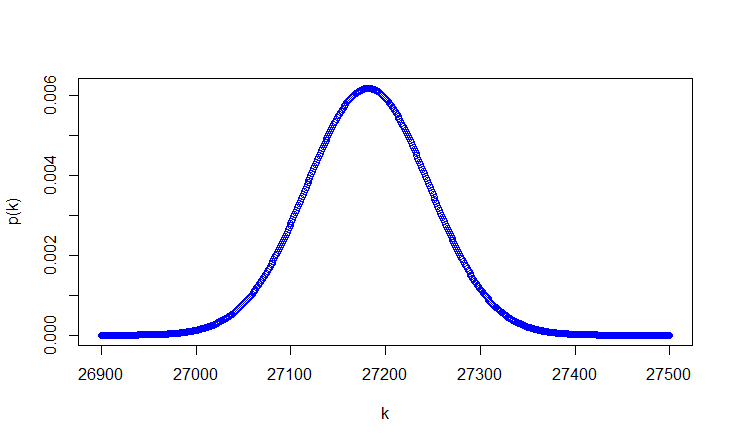This is related to the Coupon collector's problem as noted in the comments.
Building off of this post, the probability of observing $k$ unique letters in $m$ random uniform samples from an alphabet of size $n$ is:
$$\bigg\{\!{m\!\atop{k}}\bigg\}\binom{n}{k}\frac{k!}{n^m}=\bigg\{\!{m\!\atop{k}}\bigg\}\frac{n!}{n^m(n-k)!}$$
Where $\big\{\!{m\!\atop{k}}\big\}$ is the Stirling number of the second kind.
For large $m$, $\ln\!\big(\big\{\!{m\!\atop{k}}\big\}\big)$ can be approximated.
Here is an R function that returns the probability of every $k$:
library(copula)
coupons1 <- function(n, m) {
l <- min(m, n)
k <- 1:l
if (m < 200) {
logS <- log(Stirling2.all(m)[k])
} else {
# estimate the log Stirling numbers
v <- m/k
G <- 1/v
vexpv <- v/exp(v)
for (i in 1:5) G <- G - (G - (vexpG <- vexpv*exp(G)))/(1 - vexpG) # Newton's method
if (l == m) G[l] <- 1
logS <- (log(v - 1) - log(v*(1 - G)))/2 + (m - k)*(log(v - 1) - log(v - G)) + m*log(k) - k*log(m) + k*(1 - G) + lgamma(m + 1) - lgamma(k + 1) - lgamma(m - k + 1)
}
exp(logS + lgamma(n + 1) - lgamma(n - k + 1) - m*log(n))
}
The probability of $k=1,2...43000$ for $n=m=43000$:
system.time(k1 <- coupons1(43e3, 43e3))
#> user system elapsed
#> 0.02 0.00 0.01
plot(26900:27500, k1[26900:27500], xlab = "k", ylab = "p(k)", col = "blue")
Comparing that result to a brute-force approach:
Rcpp::cppFunction("
NumericVector coupons2(const int& n, const int& m) {
int maxk;
int n1 = n - 1;
if (n > m) {
maxk = m;
} else {
maxk = n;
}
NumericVector k (maxk);
k(0) = 1;
for (int i = 1; i < maxk; i++) {
for (int j = i; j > 0; j--) {
k(j) = (k(j - 1)*(n - j) + k(j)*(j + 1))/n;
}
k(0) = k(0)/n;
}
for (int i = maxk; i < m; i++) {
for (int j = n1; j > 0; j--) {
k(j) = (k(j - 1)*(n - j) + k(j)*(j + 1))/n;
}
k(0) = k(0)/n;
}
return k;
}
")
system.time(k2 <- coupons2(43e3, 43e3))
#> user system elapsed
#> 12.29 0.00 12.31
The relative error from using the Stirling number approximation is small for a large $m$.
max(abs(k1[26900:27500] - k2[26900:27500])/k2[26900:27500])
#> [1] 8.288009e-07
points(26900:27500, k2[26900:27500], col = "orange", pch = 20)
legend("topright", legend = c("k1", "k2"), col = c("blue", "orange"), pch = c(1, 20))
A note on the occupancy R package:
The occupancy package features the distribution for this problem, with an option for exact or approximate calculations. docc returns the PMF of k. However, it is much slower than coupons1 and coupons2 above, with the computation time growing approximately geometrically for $m=n$. Additionally, the approximation provided is poor compared to the one provided by coupons1:
n <- 43e3L
system.time(k3 <- occupancy::docc(1:n, n, n, approx = TRUE))
#> user system elapsed
#> 1.61 2.00 3.61
max(abs(k3[26900:27500] - k2[26900:27500])/k2[26900:27500])
#> [1] 0.01156602
Time occupancy::docc for $m=n=4300$ with approx = FALSE:
n <- 4300L
system.time(occupancy::docc(1:n, n, n))
#> user system elapsed
#> 35.58 0.14 35.75


